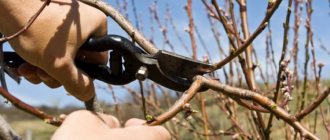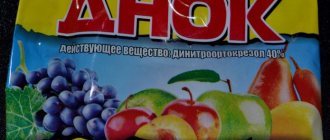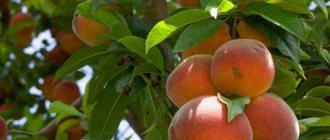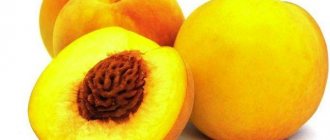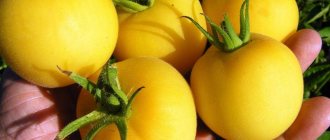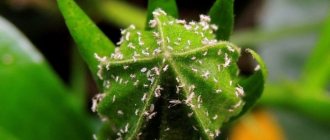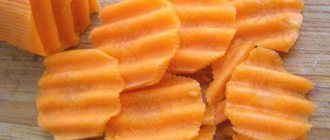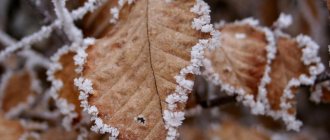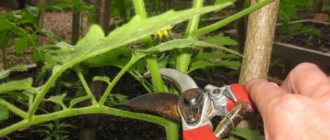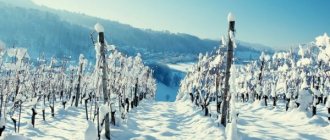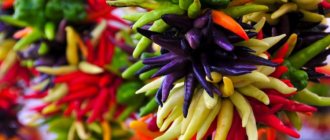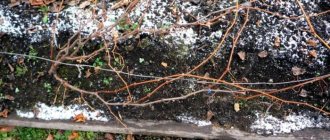Harvest beds Peach
Author of the article: Igor Ilyin | Updated: 04/18/2019
One of the most capricious fruit crops is called the peach. Gardeners in the central and northern regions will have to make a lot of effort to achieve abundant fruiting and good endurance of this crop. Today we will tell you how to cover a peach for the winter.
- 1 Why insulate
- 2 Video: “Insulating a peach tree for the winter”
- 3 Preparation
- 4 Cover 4.1 For roots
- 4.2 For the barrel
Why insulate peaches for the winter?
Previously, you had to go to the Crimea or the Caucasus to buy peaches, but today these delicious fruits can be grown in cooler regions. Competent selection and special agricultural technology helped to achieve this.
Despite the cold-resistant varieties bred by breeders, the southern tree still needs to be insulated. If you do not cover the peach for the winter, the tree will probably freeze at the first severe frost. Peach trees, regardless of variety, are demanding in terms of growing conditions and require delicate handling.
Why you need to insulate your peach for the winter:
- does not tolerate severe frosts characteristic of the middle zone;
- afraid of sudden cold snaps;
- reacts negatively to winter storms;
- a frozen tree will not give a good harvest, the yield will drop - the fruits will be small or there will be none at all;
- protection from the negative effects of ultraviolet rays;
- protection from rodents;
- the tree may die.
Taking into account the peculiarities of the Russian climate, it is necessary to cover peach for the winter in all regions where winter temperatures drop below -15°C. But winter is unpredictable, and even the warmest regions can experience critical frosts. In addition, in the south there are icing events, which are extremely destructive for any trees. To insulate or not to insulate a peach in the south - each gardener decides for himself.
The peach tree is small, and every part of it is vulnerable. To protect the tree from severe Russian frosts, it is necessary to insulate all its parts:
- trunk;
- root system;
- crowns;
- basal neck.
How to insulate an apricot for the winter. Features of overwintering apricot trees
The most destructive thing for apricots, regardless of their age, is the negative impact of winter thaws, which can provoke early biochemical processes. A sharp cold snap can cause irreversible damage, including the death of flower buds. Temperature changes are especially dangerous for young and newly planted fruit trees. In this regard, the question arises of how to properly insulate an apricot for the winter.
It is necessary to distinguish between the concepts of “winter hardiness” and “frost resistance”. The term “winter hardiness” refers to all the unfavorable factors of winter - winds, frosts, changes in humidity and temperature. The winter hardiness of the Apricot species, including its northern varieties, is still insufficient.
The concept of “frost resistance” is much narrower and means resistance to cold. In an ordinary apricot it is quite high. In the Volga region, apricot trees tolerate harsh winters quite well for many years.
The apricot's deep dormancy is quite short - until the beginning of December. All winter the trees are in a state of forced dormancy. This means that they are already capable of flowering and growing; only negative temperatures stop them from doing so. To start growth you need just a little heat. Even a thaw is enough for the apricot to begin to grow.
During the summer, fruit-bearing trees accumulate nutrients that are necessary for successful overwintering. Apricots in the south are covered with a “coat” of similar chemical compounds. In the middle zone, summers are moderately warm, so apricots do not have time to stock up on nutrients. They winter in a “light coat”.
It is worth noting the advantages of an early thaw. Apricot annually lays a large number of flower buds on annual shoots, regardless of the previous year's yield. If partial death of the buds did not sometimes occur, the tree would quickly become depleted and their lifespan would be shortened. This phenomenon is quite normal, this is the natural restoration of the apricot’s strength.
Timing and methods of shelter
The timing of peach insulation for the winter depends on the climatic conditions in the region and on specific weather conditions.
But before starting to insulate the tree, gardeners prepare the peach for winter. Peach trees require special care in the fall. The main autumn activities are pruning and spraying. Having completed all the preparatory work, gardeners begin insulation.
They begin to insulate a tree under the following conditions:
- the leaves on the trees have completely fallen;
- The first frost hit.
Typically, preparatory activities take place from the end of September to the beginning of October. Adjusted for region and weather conditions. Warming is carried out 2-3 weeks later.
An insulated peach has every chance of surviving the winter safely. The main thing is to choose the right method of shelter, corresponding to the level of threats, and remove the insulation in time. If you delay in “uncorking” in the spring, the tree may rot.
The shelter method is selected taking into account the regional climate. Options for covering seedlings and mature trees:
- Warming the roots with humus. Instead of soil, a peat-humus mixture is used for hilling. The soil freezes quickly. And if the winter is not snowy, then the protective layer may not be enough and the roots will freeze. Other materials can be used for mulch.
- Cover with spruce branches or corn stalks. These materials allow you to create a well-ventilated protective layer. Such insulation saves the roots and part of the trunk from cold, rain, sleet, and wind.
- Dropping to the grafting level. This method is used to preserve seedlings. First, they dig a hole about half a meter deep, place seedlings in it at an angle of 45 degrees and dig in with soil. A prerequisite is that the seedlings must be positioned with their tops facing south.
- Thermos style shelter. The covering material is placed around the trunk, leaving a gap between them. The empty space is filled with sawdust. The structure is covered with a film on top to protect the sawdust from getting wet.
- Construction of a “hut”. The tree must be completely covered. All parts of the tree, including the crown, should be in the hut. First, a frame is built, and then covering material is thrown over it. To make the frame, metal hollow tubes or wooden planks are used.
- Agrofibre wrap. The trunk and crown of the tree are wrapped with covering material. To make it easier to wrap the tree, the crown is pre-tied with twine.
A video about covering a peach with spunbond will help you master the insulation technique:
Why is peaches insulated?
Peach is a delicate plant, not adapted to sudden temperature changes and prolonged frosts.
It is recommended to cover the peach for the winter, regardless of the region of growth. If you do not insulate the plant, the flower buds will freeze - the ovaries will not form, and there will be no harvest. In a cold, frosty winter, the lack of preventive measures will lead to freezing and death of the peach tree. Insulating peach for the winter provides protection from freezing, cold, strong winds, and sudden temperature fluctuations. In winter, ultraviolet rays are dangerous for the plant - the difference in temperature between day and night leads to damage to the trunk. The shelter protects the tree from rodents - mice, rats and hares feed on tree bark.
Shelter rules in different regions
Different regions have their own methods of sheltering. They are selected taking into account the climatic characteristics of the region. The colder the winter, the lower the temperatures and the stronger the piercing winds, the more securely the peach is covered.
Features of peach shelter by region:
- In the southern regions, insulation is limited to hilling. In areas with warm winters, it is enough to rake the soil to the tree trunk. If snow falls, rake it up to the trunk. If there is a risk of roots freezing, instead of soil, a mixture of peat and humus is raked into the tree trunk circle.
- In regions with little snowy winters and moderate frosts, the tree trunk circle is mulched with sawdust mixed with ash. The thickness of the mulch layer is 15 cm. This method of insulation is practiced in the Krasnodar Territory, Rostov Region, and the North Caucasus. Without global shelter, frost-resistant varieties can also overwinter in the Moscow region and the central zone. Less resistant varieties are wrapped.
- In Siberia and the Urals, the most extensive protection methods are used. Here the trees are completely covered using the wrapping method or frame shelters with a crown (hut). A more radical method is also used here - bending down. The tree is first bent to the ground, secured, straw or spruce branches are thrown on top, and in winter the snow is constantly raked up.
Selection of material for insulation
When insulating a peach, a gardener decides two questions: what covering method to use and what material to choose for this purpose. The choice depends on which part of the tree is to be insulated.
Materials for insulation:
- Underground part. To protect the soil from freezing and the roots from freezing, the tree trunk circle is insulated with peat, sawdust or ordinary soil. Less often - manure and sawdust. All these materials cope well with the functions assigned to them, they are accessible and cheap. Typically, gardeners choose the material that they have on hand.
- Aboveground part. The upper part of the tree is wrapped or covered with burlap, agrofibre, spunbond, or plastic film. Spunbond is considered the best of these materials, but its cost is higher than that of its competitors.
- allows you to create a favorable microclimate under the shelter;
- can last several winters;
- This material is easy to work with.
Work order
Insulation work consists of two stages - autumn maintenance and insulation. To prepare a peach for winter, it is first trimmed, sprayed and watered, and then insulated.
The procedure for preparing peach for winter:
- Apply phosphate fertilizers. To do this, dig tree trunk circles 25 cm from the tree trunk. The depth of the grooves is 20 cm.
- Feed the tree with organic matter - mullein, peat, humus or chicken droppings.
- Carry out moisture charging. In autumn, the tree needs to be watered abundantly. Moisture prevents soil freezing, protecting roots from freezing.
- Perform sanitary pruning. Remove damaged, diseased and dry shoots. Also remove overgrown young shoots.
- Whiten the trunk to protect the bark from burns. To do this, prepare a mixture of fluff lime (2 kg), copper sulfate (250 g) and laundry soap (30 g).
- Spray the tree with lime milk. It is also recommended to treat the peach with a mixture of fungicides and insecticides to prevent disease and protect against insect pests.
- Insulate the tree. Choose the appropriate insulation method, prepare the materials and get to work.
Wintering without shelter
Only peaches grown in the south can do without shelter. Gardeners in the temperate zone, Siberia and the Urals must necessarily insulate their trees.
If you leave a peach without shelter in regions with harsh winters:
- The branches and roots will freeze. If the tree is weak, young, or the variety is not frost-resistant, the tree may die.
- Bark burns from sunlight. The winter sun can cause damage no less than frost.
- Injury to branches due to snow and ice.
- Bark gnawing by rodents. The consequences of rodent activity depend on the degree of damage. This could be a decrease in yield, disease or death of the tree.
Peach trees require increased attention in our latitudes. If you do not care for it and do not cover it for the winter, it is impossible to achieve good harvests. After spending half an hour insulating the tree, you can count on a harvest of juicy and large peaches.
Peach is a delicate crop with tasty and juicy fruits - such a tree can become the decoration and pride of any personal plot or garden. However, being a heat-loving plant, peach easily takes root in the climate of the southern regions, but requires special conditions and special care in the middle zone. Let us consider below how to properly cover a fruit tree in winter so that it does not die and continues to please the gardener with a rich harvest.
Why cover a peach?
Peach is a plant zoned in the south. Therefore, its cultivation in the middle zone requires compliance with certain agrotechnical rules. In particular, preparing the plant for the cold in autumn and covering the tree for the winter. If all the necessary measures are carried out in a timely and proper manner, then the peach will delight you with a bountiful and tasty harvest.
Thanks to preparatory measures, the tree will be reliably protected not only from the harmful effects of cold, frost, dampness and wind, but also from the harmful effects of ultraviolet radiation. The scorching rays of the sun can harm the crop no less than frost. Also, a properly constructed shelter helps protect against drying out of the root system and damage to the tree by rodents.
Do you need to insulate peaches for the winter?
The climatic and weather conditions of our strip are not optimal for southern plants, and therefore can not only negatively affect the quality and quantity of the future harvest, but also lead to the death of the plant.
That is why the main condition for growing peaches is correct and timely preparatory work. Preparations for wintering begin in the fall - after the leaves have fallen, the trees can be insulated.
But it should be remembered that there are several more procedures that are also important for getting through the winter cold easily and painlessly:
- Feeding - carried out after harvesting and the beginning of leaf fall, occurs by introducing phosphate fertilizers into tree trunk grooves located at a distance of 25 cm from the tree, up to 20 cm deep. During this period, feeding with organic fertilizers (mullein, peat, humus, chicken droppings) is also recommended ).
- Watering - autumn watering is large in volume and helps to avoid soil freezing, which means it protects the root system from the cold.
- Pruning - removing dry, damaged and overgrown young shoots.
- Whitewashing preserves the tree bark from the burns of the bright winter sun and severe frosts, and also prevents rapid warming of the trunk with the onset of spring (delays the start of sap flow, and therefore prevents premature flowering).
How to keep a peach from freezing
Preparatory work can increase the level of winter hardiness of the tree, but the sheltering procedure, nevertheless, is mandatory for the heat-loving peach. It is important to choose correctly not only what to cover, but also when.
Timing and methods of shelter
After the leaves have completely fallen off with the onset of the first frost, you can begin to cover the tree. Peaches growing in the southern regions, where the maximum temperature in winter does not fall below -15°C, do not need shelter at all.
For other regions, there are several methods for covering fruit trees:
- the root system is insulated with humus - the tree trunk circle is covered not with soil, which quickly freezes in winter, but with a mixture of peat and humus, which have a lighter structure;
- the trunk is covered with corn stalks or spruce branches - a material that creates a well-ventilated space, thereby protecting the plant from cold wind, sleet and rain;
- the trunk, up to the grafting site, is covered with earth - digging is often used as a shelter for seedlings (young trees are placed in a hole 50–60 cm deep at an angle of 45°, strictly from north to south);
- around the trunk - the covering material is placed around the tree in such a way that there is a small space between it and the trunk, where sawdust is subsequently poured (the top of the structure is covered with plastic film, which will protect the sawdust from getting wet);
- the entire tree, together with its crown, is covered with a hut - a structure consisting of a frame and covering material;
- wrapping the crown and trunk - the trunk is covered with agrofibre, spunbond or burlap, the same material is used to cover the crown pre-tied with ropes.
Features of caring for peach in the fall and when preparing it for winter - general tips and recommendations
It is very important to prepare the peach for the winter and carry out appropriate care and pruning measures. All procedures are performed at various points in the fall; preparations for the first frosts should be gradually undertaken.
The following is a list of activities that should be performed before wintering peach in the fall:
- Digging up the soil near the roots - digging up the top layer is necessary to lift the lying parasitic insects out. The shovel should be immersed completely on the bayonet, while inverted clods of earth should not be loosened. The first frost will independently kill possible pests and thoroughly loosen the soil.
- Application of mineral fertilizers - for this purpose, depressions are dug 25 cm in size and no more than 30 cm in length. They should be applied according to the following scheme: phosphorus - soil layer - potassium - soil layer.
- Watering – abundant watering is not required. Moderate application of nutrient moisture is necessary in the last days of October - in the first week of November. Late irrigation can damage the roots of the crop.
- Pruning – it is recommended to carry it out from the middle of the first autumn month for a month. During this period, all types of removal of unnecessary shoots are performed.
- Whitewashing the root trunk and lower skeletal branches is necessary so that the plant does not get burned under the bright winter sun.
- Treatment of branches and trunk from pests - chemical insecticides are used.
- Insulation - for this, the trunk near the root is covered with spruce branches or wrapped in straw mixed with sunflower stems. The insulation material is tied with ropes and topped with either thick paper or burlap.
By preparing a peach in the autumn, you don’t have to worry about its condition in winter. In such conditions, the tree will overwinter well and will delight you with abundant flowering in the spring.
Preparation
The most common mistake gardeners make is improperly preparing the fruit tree for wintering and the lack of a covering layer for the period of cold weather. Preparing peach for winter begins in early autumn, when the entire fruit crop has already been harvested. First, the tree is inspected for the presence of parasitic individuals and treated with microbiological preparations that increase the protective properties of plants.
Loosening, moistening and adding potassium and phosphorus fertilizers to the soil are mandatory procedures for autumn care and preparing peach for winter. Soil saturated with oxygen and various nutrients contributes to the normal functioning of vegetation during the wintering period.
On the eve of the winter cold snap, you need to trim the crown of the peach tree. Most gardeners adhere to the rule that autumn is the optimal period for removing old, lifeless branches damaged by winds, insects, rodents and various diseases. Crown pruning is carried out from mid-September to mid-October so that the tree has time to heal its “wounds” and recover before the first frost.
Peach pruning in autumn
The removal of peach branches that have grown over the period must be carried out in order to increase the future yield so that the crop can favorably survive a strong drop in temperature.
Peach is a plant that requires pruning at different times of the year:
- Spring - carried out “on a rose bud” . Old trees require a rejuvenation procedure. Young seedlings 2-3 years old undergo pruning to form a crown. Restoring is also advisable - to cut off all frost-damaged shoots.
- Summer - thinning of grown young shoots , which contribute to the thickening of skeletal branches. Removing dry branches that were missed in the spring and damaged by pests and diseases.
- Autumn – sanitary cleaning of diseased sprouts infested with pests. Removing branches that have broken off due to weather conditions and the weight of the harvest.
Each period of eliminating excess growth is important in its own way. For high-quality growth and good fruiting, you need to monitor the condition of the fruit tree throughout the year .
It is recommended to carry out autumn pruning of peach immediately after the harvest is harvested , but no later than mid-October. In addition, you need to choose a dry, windless and sunny day. In damp weather conditions, the atmosphere has a favorable effect on the attachment of infections and bacteria to fresh cuts.
Note! Pruning peach trees in the fall is necessary to properly prepare the plant for winter. In addition, all root stepsons are eliminated. They can overwinter harmful insects that can crawl from an infected seedling to a healthy peach.
Removal of excess growth is carried out only with clean garden tools disinfected with potassium permanganate . For different branches, a specific device is taken: a garden saw, a knife and a pruning shears.
The autumn peach pruning scheme includes the following procedures:
- The upper branch is cut off at the very base.
- The upper branches from the side are removed along the top, leaving 2-3 eyes on the lower shoots.
- It is necessary to thoroughly thin out the shoots growing inward so that the skeletal branches are not thickened, and future fruits have space to grow and be saturated with sunlight.
- Diseased, dry or mechanically broken shoots are removed completely.
- Thin and long green shoots that have not yet ripened need to be shortened by 50%.
A young peach seedling , planted for permanent residence, is subject to crown formation already in the first autumn . The top of an annual peach is trimmed so that the height of the tree from the ground is 50 cm.
In the 8-10th year, it is recommended to rejuvenate the peach . To do this, carry out the following steps:
- Broken and dried branches are pruned.
- Fruiting shoots on which fruit formation is not observed must be cut off by a third of the entire length.
- Control the growth of the peach so that it does not exceed 3 meters.
- All skeletal branches need to be cut back to the level where they were at 3-5 years of age. The stump is made near a young and strong branch. It will later become a continuation of the skeletal one.
- If the forecast for the winter is disappointing, with severe frosts and heavy precipitation, it is worth removing all thin and green branches.
Important! Not all varieties need to be pruned in the same way; some require special care. It is recommended to additionally trim such types of peach as Boxer, Royal, Autumn Blush, Glory, Skif, Krasnodarets using “household” pruning.
A large number of fruit-bearing buds form on the branches of these trees. During ripening, the fruits greatly weigh down the branch and prevent each other from fully developing and being saturated with sweetness.
Growing peach in the cold conditions of Siberia and Northern Russia
Peach
Peach. Is the frost scary for him? What's the harvest like? Menu for peach. Plant in stale form. Growing peach as a bush. Watering. Fertilizer growing under the tree
Is the frost scary for him?
Although the peach has always been considered a southern crop, very demanding of heat, this does not stop many enthusiasts from trying to grow the capricious tree in more severe conditions. And now, when winter is in full swing, gardeners should weigh in: maybe it’s worth taking up the task of “relocating” the southerner?
The famous fruit grower M.I. SUKHOTSKY, analyzing the experience of cultivating peaches in the conditions of Belarus, came to the conclusion that it is possible to obtain stable yields from this crop. This is favored by several reasons: firstly, summer heat is enough for fruit ripening, secondly, peach flower buds are more winter-hardy compared to other stone fruits, thirdly, spring frost of about minus 3 degrees during flowering does not affect the future harvest , and fourthly, if damaged in harsh winters, the plant recovers well.
These statements are supported by long-term phenological observations, which show that peach in Belarus cannot produce a harvest in only 4 years out of 30. And with favorable summer and autumn and good hardening, it is able to withstand a short-term drop in temperature to 28 degrees below zero. This means that it can easily be grown in central Russia, where in recent years the climate has become milder.
What's the harvest like?
The peach tree grows quickly and begins to bear fruit. With proper care and the absence of winter damage, in the second year after planting you can get 2-4 kg of fruit from the tree, in the third - 10-15, in the fourth - 20-30. During full fruiting (5-10 years), the tree can produce 40-60 kg of fruit. The lifespan of a peach is 12-25 years.
When caring for peach, special attention should be paid to the formation of the crown, and this should begin already at planting. It is worth noting that for most regions, bush and slate forms are best suited.
Menu for peach
Gardeners should pay special attention to feeding and watering peach plants. Then they grow well and are more resistant to pests and diseases. It is best to feed the trees with fermented mullein in a ratio of 1:10 or chicken droppings (1:20). If this is not possible, you can apply mineral fertilizers (nitrogen, phosphorus, potassium) 1 matchbox per 10 liters of water. The first feeding is carried out in early April, the next two a month later. In the first feeding it is necessary to give more nitrogen, in the last - potassium. At the beginning of July, all feeding should be stopped.
In dry times, trees must be watered before fertilizing so as not to burn the roots. After 2-3 years, the peach should be given organic fertilizers at the rate of 20-30 kg per tree, covering them along the perimeter of the crown to a depth of 30 cm.
Plant in stale form
If it is necessary to grow a plant in a stale form, then when planting the seedlings are cut so that the stem is 7-15 cm high, and they try to get 3-4 branches from the remaining buds - the basis of the future bush (see figure, position a). In mid-autumn, half of the branches are bent and pinned to the ground with wire, the rest are left in an upright position. When the ground freezes, the “sticks” are cut into 2-3 buds (b). Then the entire plant is covered with sawdust in bags (this is most reliable) or with snow. In the spring of next year, the bent branches are straightened vertically (c). They will give a harvest. Replacement shoots will grow from the trimmed vertical branches (stumps). In mid-September they are laid on the ground and pinned. The branches that bear fruit are left in an upright position and, after the soil freezes, they are cut into 2-3 buds (g). For the winter, the plant is covered again.
It is necessary to take into account that an elastic branch that bends with difficulty cannot be bent from a wound - it will definitely break off. It is best to apply “training”: gradually bend the shoot, slightly swaying it, lower and lower. This may take several days.
Growing peach as a bush
When growing a peach as a bush, you should be very careful about covering it for the winter.
In the fall, I install a box made of planks and covered with plastic film around the bush. Its height should be such that the bush is completely hidden in this “house”, and the distance to the trunk is 50-70 cm.
When constant frost sets in - the temperature drops to 15-20 degrees - I fill this box tightly with straw. Peaches winter well in such a shelter. And even if the upper part of the crown freezes, you can simply shorten it in the spring without damaging the harvest.
At the same time, I would like to note that hilling the bush with snow led to the opposite results: the shoots in this case were severely damaged by frost.
Watering
Peaches are not considered “water crops,” but if the weather is dry, they need to be irrigated for normal development and a good harvest.
During the growing season, it is enough to water the plant 3 times, but the moisture must penetrate the soil to a depth of 60-70 cm - this is where the main part of the roots of the peach is located. The first watering is done in early June, the second in the first half of July and the third a month later.
Fertilizer growing under the tree
To provide the peach with nutrients, I sow green manure crops between the rows of plantings.
For this I use spring and winter forms of rapeseed, rapeseed, lupine, and oilseed radish. The latter grows very quickly, and within a month after sowing it can be plowed into the soil. This organic matter completely replaces humus. At the same time, peaches even winter better.
Bones - don't throw them away!
I collect the seeds of purchased peach fruits, wash them, dry them in air, place them in a container with wet sand for stratification and bury it in the ground in the fall to a depth of 50-60 cm.
In winter, I periodically dig up a vessel and inspect the bones. I plant the hatched ones in separate pots. By spring I already have quite strong seedlings, which after the end of the frost I plant in a permanent place without disturbing the roots, and at first I provide them with shading to protect them from the sun.
It is quite possible to grow peaches from stones, although in this case the seedlings do not always inherit the best parental qualities. But they will certainly acquire one property: they will adapt to the climate where they grew up.
Read 16473
times Last modified Friday, March 09, 2021 11:14
Sheltering a peach for the winter
Attention! Peach is a delicate, demanding and delicate crop. He is very afraid of strong drops in air temperatures and cold, piercing winter hurricanes. Therefore, it is necessary to form protection for the roots, trunk, root collar and crown.
Video: preparing peach for winter shelter
Proper preparation will allow the tree to survive any frost without loss. To do this, you should perform the following activities:
- Dig up the soil next to the trunk and water it . Moisture, thanks to the loosened soil, will flow to a depth of 1 meter. This will allow the roots, provided with nutrient water, to freeze less.
- Spray with fungicides or Bordeaux mixture to prevent the appearance of pests and diseases.
- Mulch the area under the crown - fallen leaves, sawdust, and humus are suitable for this. The procedure is carried out after frost in dry weather.
- Insulation with burlap - it is wrapped around the trunk in several layers.
- Protecting the peach crown from frost - it is better to erect supports next to the tree and wrap the crown with covering material. Any material is suitable for this - roofing felt, thick paper, old wallpaper, agrofibre. You should not use polyethylene; condensation often forms under it, which promotes rotting and the appearance of fungus.
Video: how to cover a peach for the winter with spunbond
This peach shelter for the winter is made with all varieties of fruit crops. Differences between species are not highlighted. A well-insulated tree can overwinter warmly, without diseases or pests. The main thing is to bloom abundantly in the spring.
Video: how to prepare and cover a young peach for the winter
Sheltering plants for the winter. Types of covering material
- spruce branches of coniferous trees;
- foliage;
- sawdust;
- artificial materials: agrofibre, agrotex, lutrasil, jute material, burlap and others.
Some people use straw to cover plants for the winter. But straw is often favored by mice, so it is better to avoid it.
Using coniferous spruce branches
Coniferous spruce branches retain snow well, thereby retaining heat. In addition, mice try to avoid it. If there is little snow, then spruce branches will be poor protection from the cold. In this case, it is necessary to throw snow onto such a shelter.
Another important detail in the use of spruce and pine spruce branches is that they must be selected from apparently healthy trees in order to avoid the introduction of diseases and pests into your area. It should also be noted that in the forest spruce branches can be collected (according to forest legislation) only from cut down trees. Therefore, if you have coniferous trees growing on your site, then it is better to collect spruce branches from them.
fallen leaves
Fallen leaves are the most accessible covering material. It can be used to cover the tree trunks of seedlings and bushes. The disadvantages of using fruit tree foliage is that it decomposes quickly, so there may not be enough to last through the winter. Moreover, during thaws, such a layer of leaves does not allow air to pass through well, which contributes to damping off of the plants. If such material is used as a shelter, it is best to take oak or birch foliage - it will last all winter.
The foliage must be dry. Therefore, it is prepared on a sunny day and stored in a dry place.
To ensure that the foliage remains dry for a long time, it is covered on top with a breathable material, for example, agrofibre, put on a ready-made frame or made independently.
In the spring, it will be easier to remove the remains from such a shelter if you put the leaves in mesh bags in which vegetables are usually sold.
Covering with sawdust
Sawdust is mainly used for mulching plants.
To cover the plants themselves, it is necessary to use dry sawdust, which cannot be preserved in this quality throughout the winter. To prevent sawdust from getting wet, they are insulated with polyethylene. But with this method there is a risk of damping off.
Artificial materials
Artificial materials are divided into non-woven materials specially produced for agricultural work: agrofibre, agrotex, lutrasil, etc. and various improvised materials, such as burlap. The main property of nonwoven materials is that they release moisture outside, preventing it from penetrating from the outside. Another advantage of such materials is that they allow ultraviolet rays to pass through. This property ensures that fully covered plants, such as roses, do not completely get used to the sun and, accordingly, in the spring, after removing the cover, they are less likely to get sunburn.
But for the same reason, such materials cannot be used to protect coniferous plants from burns.
To protect conifers from the sun, from about February, it is better to use burlap, jute material or other dense light fabric that blocks ultraviolet radiation. It is important here that the plant breathes under such material.
The ideal option for protecting conifers from the sun is to use special barriers (screens) that shade the plants only during the most active sun during the day.
Jute material is well suited for protecting the root system from cold and tree trunks from rodents. It is sold almost ready for use.
What are the features of preparing peach for winter in individual regions?
Peach is planted not only in southern cities, but also in other parts of vast Russia. So that it can survive the winter well, different regions use unique methods of covering the tree for the winter.
By the way! There are no particular differences in covering peach for the winter among regions. So in the Urals and Siberia, as well as in the Moscow region and the Volga region, volcano huts are erected or wooden frames are installed. This method allows you to preserve the crop shoots as much as possible and preserve fruit-bearing buds.
In the Moscow region and the Volga region, some farmers do not cover their trees, and most varieties of peaches survive the winter safely. The wood does not suffer much, which cannot be said about flower buds - all of them - but a lot of them freeze. That is why gardeners have come to the conclusion that it is better to cover peaches in the middle zone for the winter.
Insulation is carried out after the first frost (-5..-10 C). For this purpose, huts are erected. Underneath them, the branches are tied with ropes to the trunk, and on top are placed blocks of wood, secured to each other with screws. Sheets of mineral wool are placed on the structure, which are covered with polyethylene on top so that the structure does not get wet by rain.
Video: covering a peach for the winter with slate
The southern side is additionally covered with slate to protect it from the bright sun. But in the spring, on the first sunny days, all insulation is removed so as not to provoke rotting.
Thus, shelter is necessary in any situation and in any frost. The greater the frost, the less likely it is for a successful outcome for the fruit crop.
PEACH VARIETIES FOR THE MOSCOW REGION
TALKING ABOUT PEACHES, HOW CAN YOU NOT REMEMBER SEROV’S PICTURE “GIRL WITH PEACHES”! IT IS KNOWN FOR DEFINITELY THAT THESE TASTY FRUITS WERE LOCAL, GROWN IN THE GREENHOUSES OF THE MAMMOTH FAMILY IN THE VILLAGE OF ABRAMTSEVO, SERGIEVO-POSAD DISTRICT, MOSCOW REGION. THE PICTURE WAS PAINTED IN 1887. WHAT HAPPENS TO THE MOSCOW PODIUM PEEACHES NOW?
© Author: KSENIA KRUGLOVA, Candidate of Biological Sciences
Let's try to grow a heat-loving peach in our northern gardens..
There are still no peach varieties recommended for outdoor cultivation (except for the North Caucasus region). But selection work is underway. There are varieties of folk selection. Peach culture, although not quickly, is moving towards the northern regions of our country. There are several varieties included in the State Register for the southern regions of Russia, but they can be considered as candidates for a garden near Moscow.
Several important recommendations for growing peaches have been developed for the Moscow region. You need to select a place for this plant that is protected from the winds, fertile, and without close groundwater. This is clear to everyone: after all, he is a southerner.
But not everyone knows that a peach harvest can actually be obtained if the plant is formed not as a tree (as is usual in our ideas about a peach), but as a spreading bush. To do this, cut off the central conductor and do not cut off the branches extending horizontally from the trunk, specifically provoking tillering.
Although, like 200 years ago, you can grow miniature peach trees in pots, removing them annually for the winter in basements or unheated greenhouses.
In any case, it’s possible to feel like Mamontov’s patrons of art with peaches from your own greenhouse. There would be a desire!
Typical mistakes in caring for peach in the fall and when preparing it for winter
Important! Caring for the plant must be done tirelessly, its growth must be monitored, and broken and damaged branches must be removed.
If you do not perform simple operations, the peach will become overgrown, stop bearing fruit, and may freeze in winter. The following mistakes are made by gardeners:
- Untimely pruning - if you start doing it while there is foliage on the tree, the plant will suffer, lose a lot of nutritious juice and weaken the immune system.
- An untreated cut is an excellent entry point for viruses and pathogenic bacteria to house pests for the winter.
- If you do not prune damaged or diseased branches , then when the first rays of sunlight appear, the pests will attack the weakened tree with renewed vigor.
- After the tree trunk circle has been dug, there is no need to loosen the clods of earth . If you loosen them, then all the pests will again hide in the soil.
- In damp, rainy weather, you should not bother with insulation - all the material will get wet and, instead of insulation, will serve as a refrigeration chamber for the wood.
Thus, by following simple rules for caring for a peach in the fall and preparing it for winter, and trying not to make mistakes, in the spring you can get not only a healthy tree with high immunity, but also one that is ready to produce a bountiful harvest. The main thing in obtaining a large number of fruits is the preservation of fruit buds in winter.
